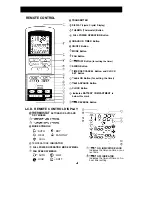
OPERATING TEMPERATURE RANGE
INDOOR TEMP. OUTDOOR TEMP.
upper limit
32°C D.B.
46°C D.B.
COOLING
23°C W.B.
lower limit
21°C D.B.
21°C D.B.
15°C W.B.
limit
27°C D.B.
21°C D.B.
H E A T I N G
lower limit
20°C
-95°C W.B.
D.B.=Dry-bulb
WHEN POWER FAILURE OCCURS
A built-in protective device
might prevent the unit from
operating when used out of
this range.
Condensation might form on
the air outlet when the unit
operates continuously in the
COOL or the DRY mode
when the humidity is over 80
percent.
This air conditioner has a back-up function in case of power failure during operation.
After power recovery, the unit will automatically restart in the same settings which were
before the power failure, except for timer operation settings.
If the timers are set, they will need to be reset after power recovery.
PREHEATING FUNCTION
In the HEAT operation, the indoor fan might not start for two to five minutes after the unit is turned on
to prevent the air from circulating before the unit is sufficiently warmed up.
DE-ICING FUNCTION
l
When ice forms on the heat exchanger in the outdoor unit during the HEAT operation, an
automatic de-icer operates for about 5 to minutes to remove the ice. During de-icing, the inside
and outside fans stop operating.
l
A hissing sound may be heard originating from the indoor unit during de-icing.
l
After de-icing is completed, the unit automatically resumes operation in the HEAT mode.
HEATING EFFICIENCY
l
The unit employs a heat pump that draws heat from the outside air and releases it into the room.
The outside air temperature therefore greatly affects the heating efficiency.
l
If the outside temperature is unusually low, you may require additional heating to maintain the
desired room temperature.
l
On very cold days, it may take some time to heat the entire room, you may need to use the “full
power” feature to speed up heating.
Below are some simple ways to save energy when you use your air conditioner.
SET THE CORRECT TEMPERATURE
Setting the temperature 1
higher in COOL mode, and 2°C lower in HEAT mode than the desired
temperature can result in a 10 percent saving in electricity.
l
Setting the temperature colder than necessary during cooling will result in excess power consump-
tion.
KEEP OUT DIRECT SUNLIGHT AND DRAFTS
l
Keeping out direct sunlight when cooling will aid in reducing the power consumption.
l
Close the windows and doors when heating and cooling the room.
SET PROPER AIR FLOW DIRECTION TO OBTAIN THE BEST AIR CIRCULATION
KEEP FILTER CLEAN TO ENSURE THE MOST EFFICIENT OPERATION
MAKE MOST OF THE TIMER OFF FUNCTION
UNPLUG THE POWER CORD WHEN THE UNIT IS NOT TO BE USED FOR AN
EXTENDED PERIOD
l
The indoor unit still consumes a small amount of power when it is not operating.




































